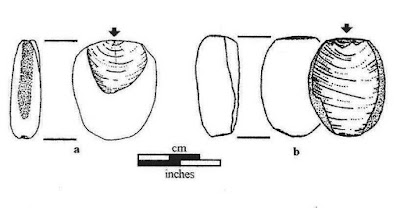Saturday, July 2, 2016
PETROGLYPHS - INDIRECT VS. DIRECT PERCUSSION REVISITED - REVISITED AGAIN:
On may 14,
2016, I posted a column titled PETROGLYPHS
- INDIRECT VS. DIRECT PERCUSSION REVISITED. In this I reported on
experimental results published in 1999 by Jim Keyser and Greer Rabiega that
addressed the question of indirect vs. direct percussion in the manufacture of
petroglyphs. Their experiments proved that the use of a stone chisel between
the rock face and the hammer stone allowed finer lines and better control in
the finished petroglyph. My original denial of the concept (January 17, 2010,
"Petroglyphs - Direct Vs. Indirect Percussion?") had been based upon commonly seen
illustrations that show the artist holding a hammer stone in one hand and a
chisel made of a flaked stone point on a wooden or bone shaft in the other,
chipping away at the rock face to make a petroglyph. Keyser had rightly
recognized that I was not considering the use of a smaller hard rock as a
chisel stone between the hammer stone and the rock face, and apprised me of the
published results of their experiments.
Figure 1, chisel stone found at
Horsethief Lake State Park,
Washington, by James Keyser, 2007.
A short time later Keyser again
contacted me and provided me with a copy of a paper he had published in 2007,
about finding just such a chisel stone at Horsethief Lake State Park,
Washington. While not directly associated with any particular petroglyph there,
he reported that it was in the vicinity of a grouping of petroglyphs. "The chisel stone, a small quartzite
river pebble measuring 3.5 x 4 x 1.3 centimeters in maximum length, width, and
thickness (Fig. 1), was found by me in the eroded foot trail used to access the
main areas of rock art in the park during a visit there in 2007. Although not
directly associated with a petroglyph, the tool was within a few meters of two
different rock art loci at 45KL58, both of which contain a few petroglyphs, and
not far distant from a third that also has petroglyphs." (Keyser 2007)
Figure 2, experimental chisel stone.
Keyser and Rabiega, 1999.
The previously reported experiments (above)
conducted by Keyser and his co-investigator had prepared him to recognize
something that most of us would probably have overlooked. "As soon as I picked it up I recognized it immediately as a chisel
stone exactly like several (Fig. 2) that I and a colleague had produced in an
experiment a decade earlier (Keyser and Rubiega 1999: 130-132)." (Keyser
2007)
While experimental archaeology such
as the project Keyser reported in 1999 cannot prove that something was
definitely done in a particular way, it can prove that something might have
been done that way. This finding of the actual artifact, however, seems to seal
the deal on it. Indirect percussion was sometimes used in the production of
petroglyphs, especially when fine details were the goal.
Keyser closed his paper with the
statement "As such, it should put to
rest the argument as to whether at least some petroglyphs were, in fact,
manufactured by this technique." It does for me Jim, and
thanks again.
REFERENCE:
James D.
Keyser,
2007, DIRECT
EVIDENCE FOR THE USE OF INDIRECT PERCUSSION IN PETROGLYPH MANUFACTURE, p.25-27,
INORA International Newsletter
On Rock Art,
www.bradshawfoundation.com,vol. 49.
Keyser,
James D. and Greer Rabiega,
1999, Petroglyph Manufacture by Indirect
Percussion: The Potential Occurrence of Tools and Debitage in Datable Context,
Journal of California and Great Basin
Anthropology, Vol.21, No. 1, pages 124 - 136.
Subscribe to:
Post Comments (Atom)






No comments:
Post a Comment